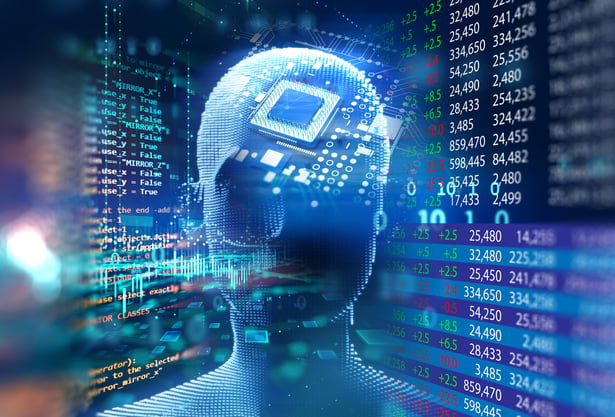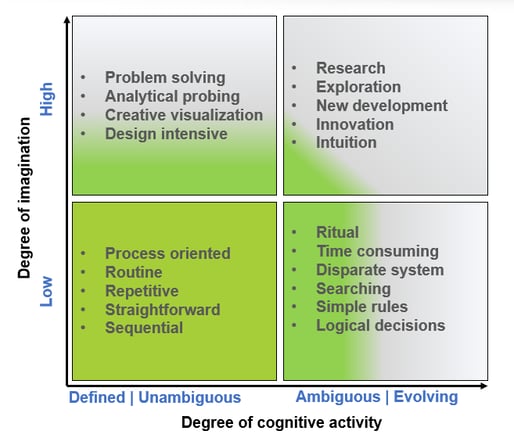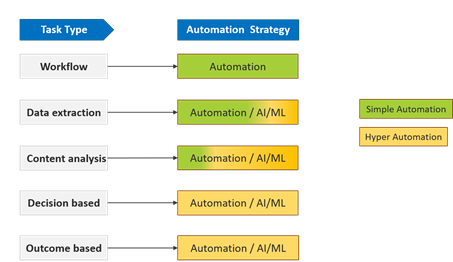The human brain is known to rely on heterogeneous data associations to enable computational functions. At a granular level, the brain is the control center. Every lobe comprises billions of cells that work together to ensure what is perceived is conceptualized into thoughts and translated into actions. While the left lobe is analytical and responsible for linear thinking, the right lobe is more creative and intuitive. The memory is a data bank for references, context, and tasks that need instructions. The peripheral nervous system generates degrees of force through sensory signals for the required external stimuli.

The human brain categorizes tasks based on the degree of imagination and cognitive activity.

The only way humans can liberate themselves from routine tasks and free up time for strategic decision making, and innovation is through technology intervention. Automation is a way of applying technology to execute and process voluminous operations efficiently and speedily; automation reduces turnaround time and improves ROI. It is an ideal way to enhance operational performance and be a strategic lever to sustain a competitive edge.
Automating redundant activities by following standard operating procedures can save cost, time and improve workflow efficiencies to reduce human error and increase accuracy. It also allows employees to take up more challenging activities that can expand their intellect and imagination, leading to better competency and deeper job satisfaction levels.
To Automate or Hyper-Automate
The benefits of automation are undeniable and do have a broader business impact. Robotic Process Automation (RPA) is the most commonly used approach to automate less critical, repetitive tasks using rule-based processes. Humanizing automation was the need of the hour, and hyper-automation got perceived as the next big thing in the automation space.
Hyper-automation utilizes AI and ML concepts integrated within an automation framework to automate processes and augment human abilities to create a more agile and informed workplace.
Hyper-automation implies more than just automation of tasks and instead focuses on collaborating with humans to interpret data cognitively and establish smart insights to make better decisions. Each business has different sets of drivers or objectives when it comes to automation. The design elements and approach for automation depend on factors such as the domain, process, technology, interdependencies, compliance to name a few. The ‘5-4-4 rule’ framework helps teams to understand and arrive at solving an automation problem. Though there are numerous ways within the solution elements, the decision to get into the right path is entirely contextual and driven by business needs.
Here are the top 5 business drivers for automation:

Let’s take a look at tasks that require automation and hyper-automation:

Gains through Automation Disruption
Here are 2 practical cases across industries where different automation scales involve computer vision principles, ML, NLP, and automation framework.
- E-commerce Website UX Analysis
Visual validation plays a significant role in websites, especially e-commerce portals. Usually, end-users face typical issues related to overlapping texts, channel orientation, network-specific or region-specific response, cropping of content, color contrast issues within the page, to name a few. Most of the sites are specific to regions, and hence manual verification is costly and time-consuming. Automation involving computer vision principles and ML-based models detect visual defects. The solution improves the coverage, reducing testing time and quality of testing, thereby improving user experience.
Manual identification and reporting of the Point of Interest (PoI) can take up to 5 minutes per image. Manual processes lead to errors, delays in faulty-image detection, and an increase in the cost of handling projects. On the contrary, automation solutions solve these issues and reduce the processing time by more than 80%. These solutions leverage machine learning models to
- Detect quality images
- Improve image quality by increasing the pixel density
- Extract text and information using OCR
- Leverage NLP to determine rules
- Use map information to cross-check the correctness
Hence, automation solutions improve the quality of output and processing time significantly.
Putting It All Together
The need for automation continues to grow across industries. Within businesses, everything needs some degree of automation to improve efficiencies, reduce cost, minimize issues, and improve end-user experience. As the scale of automation usage grows, intelligent automation has a vital role to play.
Hyper-automation can augment the automation framework with the right AI & ML techniques, thereby, providing high end-to-end automation capabilities.
With each passing day, IT services are witnessing an increased collaboration of tools, robots, and humans, which will maximize the potential of an automated digital enterprise and thereby reimagining the end-user experience.
Perspectives by Dr. Kiran Marri



